+ Open data
Open data
- Basic information
Basic information
| Entry | Database: PDB / ID: 1e8o | ||||||
|---|---|---|---|---|---|---|---|
| Title | Core of the Alu domain of the mammalian SRP | ||||||
 Components Components |
| ||||||
 Keywords Keywords | ALU RIBONUCLEOPROTEIN PARTICLE / PROTEIN RECOGNITION OF AN RNA U-TURN / TRANSLATIONAL CONTROL / ALU RNP ASSEMBLY AND TRANSPORT / ALU RETROPOSITION | ||||||
| Function / homology |  Function and homology information Function and homology information signal recognition particle receptor complex / endoplasmic reticulum signal peptide binding / signal recognition particle receptor complex / endoplasmic reticulum signal peptide binding /  signal recognition particle, endoplasmic reticulum targeting / signal recognition particle, endoplasmic reticulum targeting /  signal recognition particle binding / negative regulation of translational elongation / cotranslational protein targeting to membrane / protein targeting to ER / 7S RNA binding / SRP-dependent cotranslational protein targeting to membrane / SRP-dependent cotranslational protein targeting to membrane ... signal recognition particle binding / negative regulation of translational elongation / cotranslational protein targeting to membrane / protein targeting to ER / 7S RNA binding / SRP-dependent cotranslational protein targeting to membrane / SRP-dependent cotranslational protein targeting to membrane ... signal recognition particle receptor complex / endoplasmic reticulum signal peptide binding / signal recognition particle receptor complex / endoplasmic reticulum signal peptide binding /  signal recognition particle, endoplasmic reticulum targeting / signal recognition particle, endoplasmic reticulum targeting /  signal recognition particle binding / negative regulation of translational elongation / cotranslational protein targeting to membrane / protein targeting to ER / 7S RNA binding / SRP-dependent cotranslational protein targeting to membrane / SRP-dependent cotranslational protein targeting to membrane / secretory granule lumen / ficolin-1-rich granule lumen / Neutrophil degranulation / signal recognition particle binding / negative regulation of translational elongation / cotranslational protein targeting to membrane / protein targeting to ER / 7S RNA binding / SRP-dependent cotranslational protein targeting to membrane / SRP-dependent cotranslational protein targeting to membrane / secretory granule lumen / ficolin-1-rich granule lumen / Neutrophil degranulation /  RNA binding / extracellular region / RNA binding / extracellular region /  nucleus / nucleus /  cytosol / cytosol /  cytoplasm cytoplasmSimilarity search - Function | ||||||
| Biological species |   HOMO SAPIENS (human) HOMO SAPIENS (human) | ||||||
| Method |  X-RAY DIFFRACTION / X-RAY DIFFRACTION /  SYNCHROTRON / SYNCHROTRON /  MOLECULAR REPLACEMENT / Resolution: 3.2 Å MOLECULAR REPLACEMENT / Resolution: 3.2 Å | ||||||
 Authors Authors | Weichenrieder, O. / Wild, K. / Strub, K. / Cusack, S. | ||||||
 Citation Citation |  Journal: Nature / Year: 2000 Journal: Nature / Year: 2000Title: Structure and Assembly of the Alu Domain of the Mammalian Signal Recognition Particle Authors: Weichenrieder, O. / Wild, K. / Strub, K. / Cusack, S. | ||||||
| History |
|
- Structure visualization
Structure visualization
| Structure viewer | Molecule:  Molmil Molmil Jmol/JSmol Jmol/JSmol |
|---|
- Downloads & links
Downloads & links
- Download
Download
| PDBx/mmCIF format |  1e8o.cif.gz 1e8o.cif.gz | 104.8 KB | Display |  PDBx/mmCIF format PDBx/mmCIF format |
|---|---|---|---|---|
| PDB format |  pdb1e8o.ent.gz pdb1e8o.ent.gz | 77.1 KB | Display |  PDB format PDB format |
| PDBx/mmJSON format |  1e8o.json.gz 1e8o.json.gz | Tree view |  PDBx/mmJSON format PDBx/mmJSON format | |
| Others |  Other downloads Other downloads |
-Validation report
| Arichive directory |  https://data.pdbj.org/pub/pdb/validation_reports/e8/1e8o https://data.pdbj.org/pub/pdb/validation_reports/e8/1e8o ftp://data.pdbj.org/pub/pdb/validation_reports/e8/1e8o ftp://data.pdbj.org/pub/pdb/validation_reports/e8/1e8o | HTTPS FTP |
|---|
-Related structure data
- Links
Links
- Assembly
Assembly
| Deposited unit | 
| ||||||||
|---|---|---|---|---|---|---|---|---|---|
| 1 |
| ||||||||
| Unit cell |
| ||||||||
| Components on special symmetry positions |
| ||||||||
| Details | THE BIOLOGICALLY RELEVANT TERNARY COMPLEX CONSISTS OF CHAINSC,D AND E. THE SRP9/14 HETERODIMER FORMED BY CHAINS A AND BIS BOUND NON -SPECIFICALLY. |
- Components
Components
| #1: Protein | Mass: 9996.567 Da / Num. of mol.: 2 Source method: isolated from a genetically manipulated source Source: (gene. exp.)   HOMO SAPIENS (human) / Cellular location: CYTOPLASM, NUCLEUS? HOMO SAPIENS (human) / Cellular location: CYTOPLASM, NUCLEUS? / Production host: / Production host:   ESCHERICHIA COLI (E. coli) / References: UniProt: P49458 ESCHERICHIA COLI (E. coli) / References: UniProt: P49458#2: Protein | Mass: 12114.235 Da / Num. of mol.: 2 / Fragment: TRUNCATED AFTER K107 Source method: isolated from a genetically manipulated source Source: (gene. exp.)   HOMO SAPIENS (human) / Cellular location: CYTOPLASM, NUCLEUS? HOMO SAPIENS (human) / Cellular location: CYTOPLASM, NUCLEUS? / Production host: / Production host:   ESCHERICHIA COLI (E. coli) / References: UniProt: P37108 ESCHERICHIA COLI (E. coli) / References: UniProt: P37108#3: RNA chain | | Mass: 16277.622 Da / Num. of mol.: 1 / Fragment: ALU RNA 5' DOMAIN / Mutation: YES / Source method: obtained synthetically Details: THE RNA WAS PRODUCED BY IN VITRO TRANSCRIPTION WITH T7 RNA POLYMERASE USING RIBOZYME TECHNOLOGY. Source: (synth.)   HOMO SAPIENS (human) / References: EMBL: X01037 HOMO SAPIENS (human) / References: EMBL: X01037#4: Chemical |  Sulfate Sulfate#5: Water | ChemComp-HOH / |  Water WaterCompound details | SIGNAL-RECOGNITION-PARTICLE ASSEMBLY HAS A CRUCIAL ROLE IN TARGETING SECRETORY PROTEINS TO THE ...SIGNAL-RECOGNITIO | |
|---|
-Experimental details
-Experiment
| Experiment | Method:  X-RAY DIFFRACTION / Number of used crystals: 2 X-RAY DIFFRACTION / Number of used crystals: 2 |
|---|
- Sample preparation
Sample preparation
| Crystal | Density Matthews: 4.2 Å3/Da / Density % sol: 71 % | |||||||||||||||||||||||||||||||||||||||||||||||||||||||||||||||||||||||||||||||||||||||||||||||||||||||||
|---|---|---|---|---|---|---|---|---|---|---|---|---|---|---|---|---|---|---|---|---|---|---|---|---|---|---|---|---|---|---|---|---|---|---|---|---|---|---|---|---|---|---|---|---|---|---|---|---|---|---|---|---|---|---|---|---|---|---|---|---|---|---|---|---|---|---|---|---|---|---|---|---|---|---|---|---|---|---|---|---|---|---|---|---|---|---|---|---|---|---|---|---|---|---|---|---|---|---|---|---|---|---|---|---|---|---|
Crystal grow | pH: 5 Details: 50MM NAOAC, 10MM MGCL2, 140MM NACL, 390MM (NH4)2SO4, 21% PEG2000, pH 5.00 | |||||||||||||||||||||||||||||||||||||||||||||||||||||||||||||||||||||||||||||||||||||||||||||||||||||||||
| Crystal grow | *PLUS Temperature: 12 ℃ / Method: vapor diffusion, hanging drop / pH: 5 | |||||||||||||||||||||||||||||||||||||||||||||||||||||||||||||||||||||||||||||||||||||||||||||||||||||||||
| Components of the solutions | *PLUS
|
-Data collection
| Diffraction | Mean temperature: 100 K |
|---|---|
| Diffraction source | Source:  SYNCHROTRON / Site: SYNCHROTRON / Site:  ESRF ESRF  / Beamline: ID14-2 / Wavelength: 0.784 / Beamline: ID14-2 / Wavelength: 0.784 |
| Detector | Type: MARRESEARCH / Detector: CCD / Date: Sep 15, 1999 |
| Radiation | Protocol: SINGLE WAVELENGTH / Monochromatic (M) / Laue (L): M / Scattering type: x-ray |
| Radiation wavelength | Wavelength : 0.784 Å / Relative weight: 1 : 0.784 Å / Relative weight: 1 |
| Reflection | Resolution: 3.2→50 Å / Num. obs: 16328 / % possible obs: 94.9 % / Redundancy: 2.4 % / Biso Wilson estimate: 67.6 Å2 / Rmerge(I) obs: 0.104 / Net I/σ(I): 5.6 |
| Reflection shell | Resolution: 3.22→3.35 Å / Redundancy: 2 % / Mean I/σ(I) obs: 1.5 / Rsym value: 0.468 / % possible all: 95.1 |
- Processing
Processing
| Software |
| ||||||||||||||||||||||||||||||||||||||||||||||||||||||||||||||||||||||||||||||||
|---|---|---|---|---|---|---|---|---|---|---|---|---|---|---|---|---|---|---|---|---|---|---|---|---|---|---|---|---|---|---|---|---|---|---|---|---|---|---|---|---|---|---|---|---|---|---|---|---|---|---|---|---|---|---|---|---|---|---|---|---|---|---|---|---|---|---|---|---|---|---|---|---|---|---|---|---|---|---|---|---|---|
| Refinement | Method to determine structure : :  MOLECULAR REPLACEMENT MOLECULAR REPLACEMENTStarting model: PDB ENTRY 1914, MODIFIED Resolution: 3.2→47.46 Å / Rfactor Rfree error: 0.01 / Data cutoff high absF: 2572751.27 / Isotropic thermal model: RESTRAINED / Cross valid method: THROUGHOUT / σ(F): 0
| ||||||||||||||||||||||||||||||||||||||||||||||||||||||||||||||||||||||||||||||||
| Solvent computation | Solvent model: FLAT MODEL / Bsol: 45 Å2 / ksol: 0.266247 e/Å3 | ||||||||||||||||||||||||||||||||||||||||||||||||||||||||||||||||||||||||||||||||
| Displacement parameters | Biso mean: 57.3 Å2
| ||||||||||||||||||||||||||||||||||||||||||||||||||||||||||||||||||||||||||||||||
| Refine analyze |
| ||||||||||||||||||||||||||||||||||||||||||||||||||||||||||||||||||||||||||||||||
| Refinement step | Cycle: LAST / Resolution: 3.2→47.46 Å
| ||||||||||||||||||||||||||||||||||||||||||||||||||||||||||||||||||||||||||||||||
| Refine LS restraints |
| ||||||||||||||||||||||||||||||||||||||||||||||||||||||||||||||||||||||||||||||||
| LS refinement shell | Resolution: 3.2→3.4 Å / Rfactor Rfree error: 0.03 / Total num. of bins used: 6
| ||||||||||||||||||||||||||||||||||||||||||||||||||||||||||||||||||||||||||||||||
| Xplor file |
| ||||||||||||||||||||||||||||||||||||||||||||||||||||||||||||||||||||||||||||||||
| Software | *PLUS Name: CNS / Version: 1 / Classification: refinement | ||||||||||||||||||||||||||||||||||||||||||||||||||||||||||||||||||||||||||||||||
| Refine LS restraints | *PLUS
|
 Movie
Movie Controller
Controller




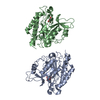

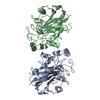
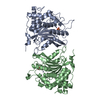


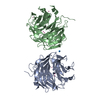
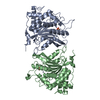


 PDBj
PDBj


































